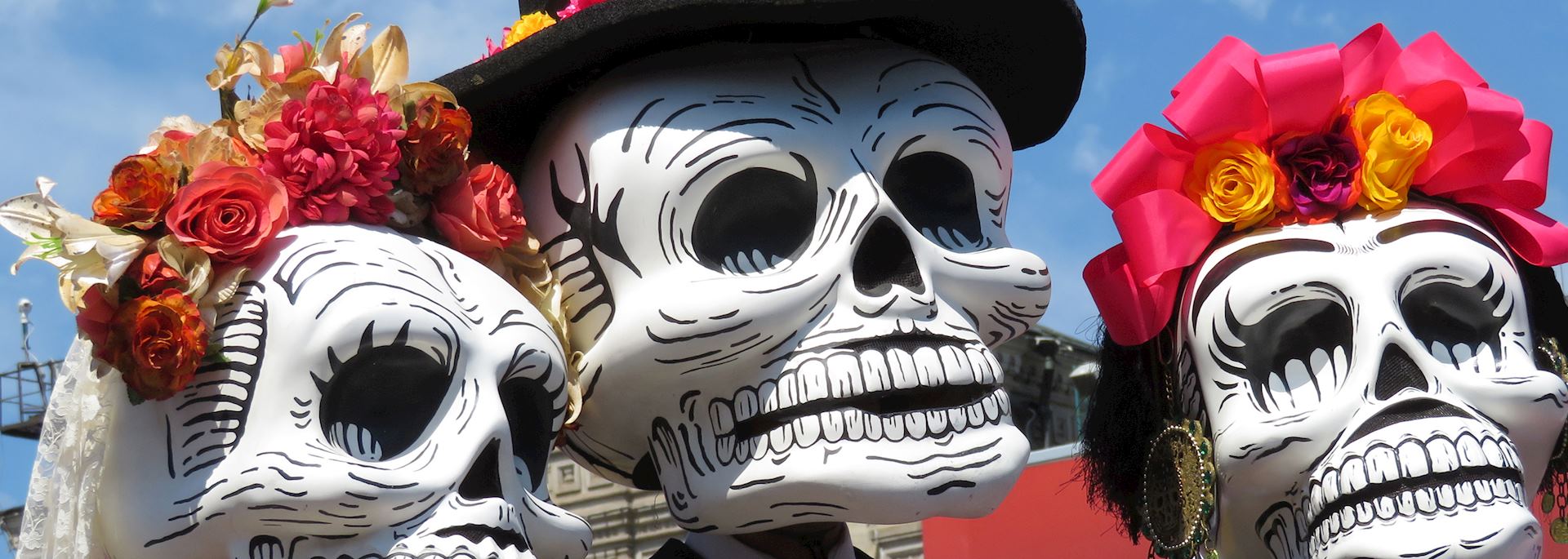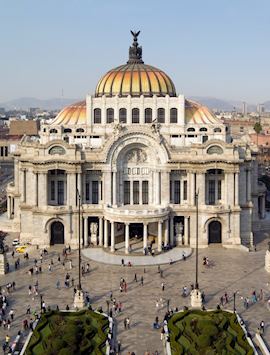By Mexico specialist Jeff
Elaborate skull facepaint. Crowns of flowers and feathered hats adorning women’s heads. Blasts of mariachi trumpets. Thousands of flickering candles and the scent of cinnamon lingering on street corners. Mexico’s Day of the Dead is a sensory affair and you might be familiar with some of these evocations — but what does the country’s most famous festival really involve? And how can you experience it on the ground?
I’ll attempt to answer these questions and give you a feel for what you can expect if you choose to visit Mexico for the Day of the Dead, and where you should go.
The Day of the Dead can be incorporated into any tour of Mexico provided you visit during late October and early November. A good sample itinerary would be this culinary-themed trip to Mexico, which includes Oaxaca, one of main hubs for celebrations.
What is Mexico's Day of the Dead? (hint: it’s not Mexican Halloween)
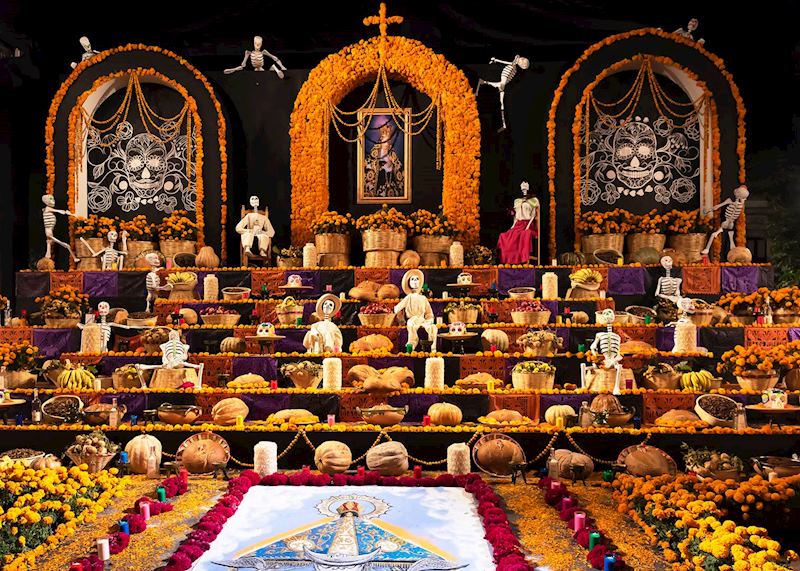
Day of the Dead (Día de Muertos) is different in tone, feel and meaning from Halloween, and different from how Halloween is celebrated in some English-speaking countries. Although the annual dates coincide, and death and the presence of spirits are a common theme, in Mexico the Day of the Dead is very much a revered, even joyous household celebration.
Families come together to remember their loved ones between October 31 and November 2, and on one of these days they’ll visit the family plot at their local cemetery (dates vary according to local calendars).
Families believe that, during this period, the deceased return to Earth. Many of the traditions surrounding Day of the Dead involve cleaning and preparing a family home or tomb for their relatives’ return.
That said… just as Halloween has pagan origins (it was originally the Celts’ New Year), Day of the Dead has distinctly non-Christian roots, and it was only after Cortés invaded that it became fused with Catholicism’s All Saints’ Day and All Souls’ Day.
The Día de Muertos comes from indigenous beliefs (including Aztec, Toltec and Maya) that held that death was only one stage in life’s long journey, and mourning the dead was therefore disrespectful. This means that Day of the Dead is celebrated most fervently in areas of Mexico that have a particularly rich pre-Hispanic heritage.
Where's the best place to experience Day of the Dead in Mexico?
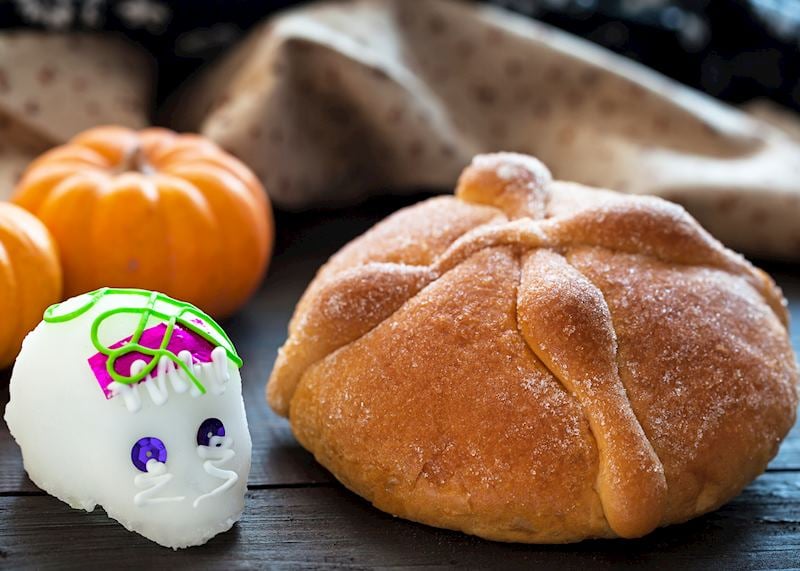
Oaxaca throws the showiest festivities, but this also means that its Day of the Dead has become quite commercially skewed in recent years. Plus, places to stay and guided tours book up well in advance. If you do choose to go to Oaxaca, we’ll show you a less-overwhelming, less-mercantile side to Day of the Dead, taking you out of the city and into smaller villages. You can even be invited into people’s homes to experience the celebrations at their most authentic (more on that shortly).
Ever since James Bond donned a skeletal mask in the opening of Spectre, Mexico City has held its own Day of the Dead procession ― a slick spectacle of dance, costumery and music. It’s a head-turning sight, but there’s not much else going on in the capital to do with the festival ― though there is, of course, plenty of places of interest in the city itself, from art museums to Aztec ruins.
For a really off-the-beaten-path experience of Day of the Dead, you could visit the villages around the stately Spanish colonial city of Morelia. The locus of their celebrations is Pátzcuaro Lake, which witnesses a procession of candlelit canoes as locals travel to a cemetery located on one of the lake’s islet.
What can you see and do during Day of the Dead?
In and around Oaxaca, you might start by visiting a local market to buy ingredients considered essential for the ofrenda, or altar, which families set up in their homes or at their relatives’ gravesides. It’s not a structure that’s intended for worship: it’s more like a portal, a temporary ‘welcome home’ gateway for the dead.
So, at a market, you and your guide might be buying items intended to feed the spirits after their long journey, such as pan de muerto (bread of the dead). This sweet, doughy, anise-spiced bread is decorated with icing-sugar skulls, bones and teardrops. Meanwhile, vendors sell candied pumpkin mixed with cinnamon for you to eat as a street snack.
Sugar is a bit of a theme, though in Oaxaca you can also expect to eat (and to see families eating) mole, an unctuous chili-and-cocoa sauce that accompanies meats. You can find out more about mole in our guide to Mexican food experiences.
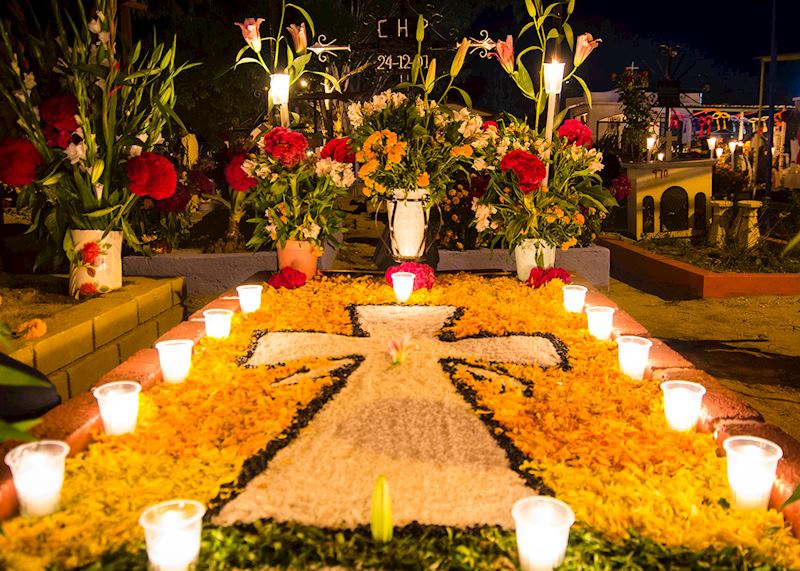
You could also buy squashes, pumpkins and loquats for the ofrenda, as well as the ubiquitous sugar skulls. A quick word on these skulls, which you’ll see everywhere (and no, unfortunately you’re not meant to eat them). Their design is often inspired by the figure of La Catrina, an elegant, ostensibly European aristocratic woman-skeleton who was originally the satirical creation of Mexican political cartoonist José Posada.
She was designed to poke fun at both Mexico’s relationship with so-called European sophistication, as well as society’s rich ― showing that death is the great leveler, that underneath our finery we’re all skeletons in the end. Today, you’ll see Catrina’s likeness staring out at you from sugar skulls and in the painted faces and extravagant costumes of revelers.
You can also visit a family’s home. They’ll show you their ofrenda and explain what all its different elements stand for: for example, in both homes and in cemeteries, you’ll see marigold flowers and petals scattered around, pointing the way home for the souls of the dead. You’ll also see that each loved one is represented by a candle, and you can visit artisanal workshops near Oaxaca to see how these candles are made.
In the evenings, you can enter a cemetery with a guide. You’ll be in a very small, unobtrusive group, so as to be respectful of the locals gathering around decorated tombs. Night falls quickly. Gravesides soon become busy with candles, families eating pre-prepared dishes and drinking hot chocolate or tequila (or whatever Granddad's preferred drink was), itinerant mariachi bands, singing and storytelling.
Parades have become indelibly associated with the Day of the Dead, but they’re not necessarily rigorously choreographed, carnival-like processions. Instead, they’re much more chaotic, spontaneous and jubilant. In the town of Soledad de Etla, near Oaxaca, a cacophony of drumming and mariachi brass fills the air, while dancers jiggle and bop along to the beat. Some wear elaborate costumes that pay homage to La Catrina, and some sport more grotesque, makeshift get-ups reminiscent of witches and Halloween monsters.
Where else in Central America can you experience Day of the Dead?
Guatemala also celebrates the festival, but puts its own twist on it: here, young people construct enormous and kaleidoscopic paper kites, intended to help wandering souls locate their loved ones. The kites are given their own festival-within-a-festival, and complement the more meditative gatherings in the cemeteries.
Speak to a Guatemala specialist to see how you can include the Day of the Dead into a tour of Guatemala.
Read more about trips to Mexico
Start thinking about your experience. These itineraries are simply suggestions for how you could enjoy some of the same experiences as our specialists. They're just for inspiration, because your trip will be created around your particular tastes.
View All Tours in Mexico